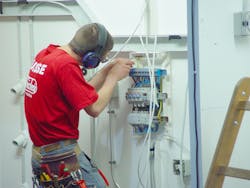Security lessons from pulling wires
I've been turning off the computer at night and working on my almost 100-year-old house doing some remodeling. One of the projects I've been doing is updating the electrical. It turns out that in the 1920s, they used a wiring method called knob and tube. This was long before the days of NM-B/Romex. The wiring was ungrounded and a positive and a neutral were run separately, about one foot apart, and wrapped in old wire insulation that seems to be made of natural materials, and which is extremely brittle. The "knob" was a porcelain clamps that kept the wire about an inch off the joists and which was also used for making 90-degree turns in the wiring. The "tube" was a porcelain tubes that allowed wiring to run through joist holes without touching the joist. Splices were done on the wires themselves – no junction boxes!
As I start remove the old wiring and replace it, I'm putting my Bosch RotoZip to heavy use with the tile cutting Xbit (XB-TC) cutting openings in plaster and lath, and I'm wearing out the brushes on my old close quarters drill with a short auger bit from Irwin. My Klein Tools fishing sticks have been getting lots of use as well – and that was just for the first switch and light in the kitchen! I can't even image what the tougher circuits are going to require.
Why do I tell you about this dusty, tedious job? Well, it's not to sell a monitored fire alarm system (although I might recommend that for any house with this age of wiring!). The two reasons have to do with video surveillance and with intrusion.
First, I wrote last week about video surveillance and how analog, while it will certainly be surpassed by IP video, is surprisingly still being used by some installers and end users. One blogger called me to task on that (chiefly because his site solely promotes network video, which is fine and which is the way our market is squarely going, but which is not yet the sum of the video surveillance market). The blogger said that "most integrators prefer to replace [coax] anyway for a variety of reasons." Sure, if I'm an installation contractor who makes money off of changing out wiring, I definitely want to replace coax. But if I'm an end-user, a wiring change-out is terribly expensive and not always necessary and may not be the first risk vector that I need to address.
In fact, I've never had an end-user tell me, "You know, what would really need improve my organization's security is to rip out and replace all my facility's wiring. In fact, our company has a capital improvement fund set aside each year just to rip out wiring. This year we ripped out our coax and replaced with network cabling, and next year we're ripping out our 14-gauge electrical and upgrading to 12 gauge."
Sure, end users may want to upgrade the wiring, but unless they have an overall failure of their video system, have a silly amount of security budget dollars, and can't use things like the coax converters, I just don't see it happening like that. At best, they'll do it in stages, and ensure that new buildings have modern IP wiring for security components. The point– to get back to my housing remodel – is that changing out wiring is extremely time consuming and very expensive, and people don't like to do it unless it's absolutely required. If not, then we tend to adapt the old wiring to new technology, just like we reuse analog infrastructure for network video.
The second lesson falls on the same topic. I'm doing the electrical routing right now and having so much darn fun at it that I can tell you one thing: When it comes time to put in the alarm system on this old house, it's going to be wireless. I was impressed with the amount of wireless alarm technology that I've seen in the last year, and I can't imagine running wires for my security system. The low voltage wiring we had to put in for the two thermostats for the HVAC system was enough of a chore, so if I can get around wiring any more low voltage, I'll take that opportunity to go wireless. There's great technology out there for wireless. I especially like what ELK Products is doing with a wireless technology that does something akin to a 2-way status handshake for status monitoring, but even the existing wireless technology has been so proven and robust that I'm going to make a prediction. Within two years it will become rare to see a new hard-wired system installed in an existing home. Tomorrow's installers won't need to do half the snaking they do today, and that's a very good thing, because it will ensure that home alarm systems stay affordable.
Now, does anyone have a Fein Multimaster or a Rockwell Sonicrafter I can borrow? I've got some outlet boxes where I need clean cuts into plaster and I've heard good things about these oscillating tools.
About the Author

Geoff Kohl
Editorial Director/Editor-in-Chief/Associate Publisher
Geoff Kohl is the Marketing Director for the Security Industry Association (SIA). He is the former Editor-in-Chief of SecurityInfoWatch.com
